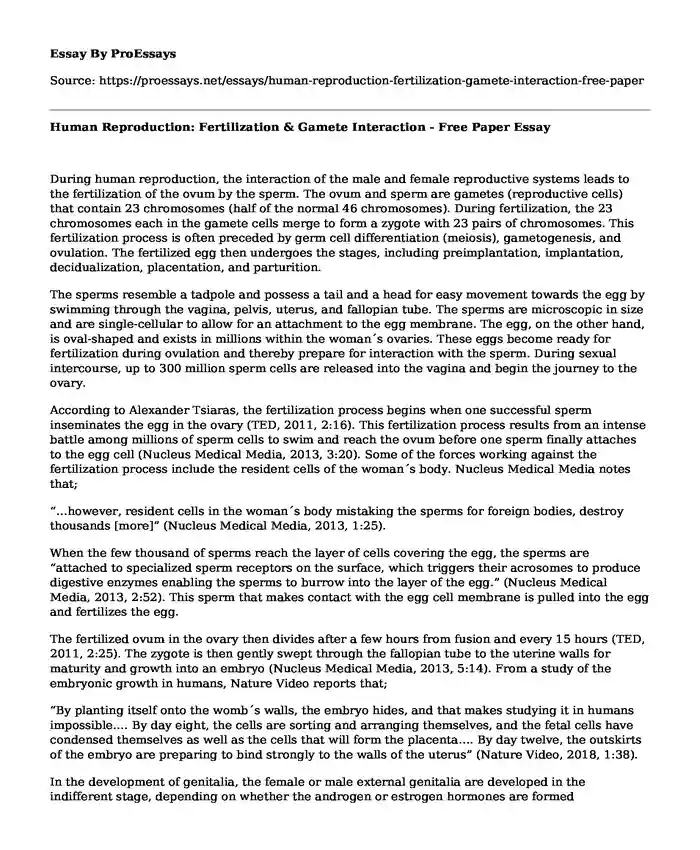During human reproduction, the interaction of the male and female reproductive systems leads to the fertilization of the ovum by the sperm. The ovum and sperm are gametes (reproductive cells) that contain 23 chromosomes (half of the normal 46 chromosomes). During fertilization, the 23 chromosomes each in the gamete cells merge to form a zygote with 23 pairs of chromosomes. This fertilization process is often preceded by germ cell differentiation (meiosis), gametogenesis, and ovulation. The fertilized egg then undergoes the stages, including preimplantation, implantation, decidualization, placentation, and parturition.
The sperms resemble a tadpole and possess a tail and a head for easy movement towards the egg by swimming through the vagina, pelvis, uterus, and fallopian tube. The sperms are microscopic in size and are single-cellular to allow for an attachment to the egg membrane. The egg, on the other hand, is oval-shaped and exists in millions within the woman´s ovaries. These eggs become ready for fertilization during ovulation and thereby prepare for interaction with the sperm. During sexual intercourse, up to 300 million sperm cells are released into the vagina and begin the journey to the ovary.
According to Alexander Tsiaras, the fertilization process begins when one successful sperm inseminates the egg in the ovary (TED, 2011, 2:16). This fertilization process results from an intense battle among millions of sperm cells to swim and reach the ovum before one sperm finally attaches to the egg cell (Nucleus Medical Media, 2013, 3:20). Some of the forces working against the fertilization process include the resident cells of the woman´s body. Nucleus Medical Media notes that;
“…however, resident cells in the woman´s body mistaking the sperms for foreign bodies, destroy thousands [more]” (Nucleus Medical Media, 2013, 1:25).
When the few thousand of sperms reach the layer of cells covering the egg, the sperms are “attached to specialized sperm receptors on the surface, which triggers their acrosomes to produce digestive enzymes enabling the sperms to burrow into the layer of the egg.” (Nucleus Medical Media, 2013, 2:52). This sperm that makes contact with the egg cell membrane is pulled into the egg and fertilizes the egg.
The fertilized ovum in the ovary then divides after a few hours from fusion and every 15 hours (TED, 2011, 2:25). The zygote is then gently swept through the fallopian tube to the uterine walls for maturity and growth into an embryo (Nucleus Medical Media, 2013, 5:14). From a study of the embryonic growth in humans, Nature Video reports that;
“By planting itself onto the womb´s walls, the embryo hides, and that makes studying it in humans impossible.… By day eight, the cells are sorting and arranging themselves, and the fetal cells have condensed themselves as well as the cells that will form the placenta…. By day twelve, the outskirts of the embryo are preparing to bind strongly to the walls of the uterus” (Nature Video, 2018, 1:38).
In the development of genitalia, the female or male external genitalia are developed in the indifferent stage, depending on whether the androgen or estrogen hormones are formed (Sqadia.com, 2018, 1:00). On the female side, changes in the indifferent external genitalia are less extensive than in the males. The genital swellings in the indifferent genitalia enlarge to form the labia majora. The labia majora then overlaps the labia minora (Sqadia.com, 2018, 4:15). Finally, the urogenital membrane then raptures so that the phallic part of the urogenital sinus forms the vestibule of the vagina (Sqadia.com, 2018, 4:24).
References
Nature Video. (2018). Building a baby: The first two weeks. Nature Video. https://www.youtube.com/watch?v=9AX1XwKCYQE.
Nucleus Medical Media. (2013). Fertilization. Nucleus Medical Media. https://www.youtube.com/watch?v=_5OvgQW6FG4.
Sqadia.com. (2018). Development of External Genitalia | Anatomy Embryology Lectures | Medical Student | V-Learning. Sqadia.com. https://www.youtube.com/watch?v=jGhD4n7_7ao.
TED. (2011). Conception to birth - visualized. TED. https://www.youtube.com/watch?v=fKyljukBE70&t=196s.
Cite this page
Human Reproduction: Fertilization & Gamete Interaction - Free Paper. (2023, Nov 18). Retrieved from https://proessays.net/essays/human-reproduction-fertilization-gamete-interaction-free-paper
If you are the original author of this essay and no longer wish to have it published on the ProEssays website, please click below to request its removal:
- Research Paper on Thyroid Cancer
- Synthesis Essay on Abortion
- Public Health in the Prevention of Diabetes Essay
- Essay Sample on Nursing: Endless Opportunities, Difficult Challenges
- Hospital Billing System: Reimbursement of Medical Services - Essay Sample
- Essay Example on Emergency Management: Preparing Communities to Counter Disasters
- Exercise Improve Alzheimer's Outcomes? - Annotated Bibliography







